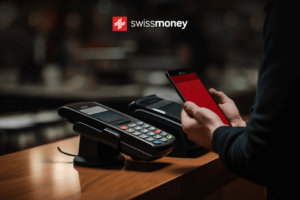Nowadays, it is unusual to see someone with a wallet in their pocket or purse. You can blame it on technology, the faster pace of life, or just plain laziness, but mobile wallets are becoming a big aspect of our more convenient lives.
But what exactly are mobile wallets, how do they operate, and which is the best choice?
What’s a mobile wallet?
A mobile wallet is a mobile payment tool you can use on your phone, tablet, or smartwatch to make online purchases.
Digital wallet stores a digital representation of a debit or credit card, doing away with the need to manually enter card information or carry the card around with you physically.
Payments can be made quickly and easily without the need for cash or plastic cards when you use a mobile wallet. With it, you can check your balance, make purchases, and even transfer money across wallets.
You can also use these wallets to store electronic tickets and vouchers, ensuring that you will never be without them. Mobile payment systems like Google Pay, Apple Pay, Samsung Pay, Garmin Pay, Amazon Pay, and others are also mobile wallets.

How does a digital wallet work?
Digital wallets work by storing your debit card information on your device, allowing for quick and easy payments wherever you see the contactless sign.
Depending on your device, you may need to unlock the wallet using biometric security like Face ID or fingerprint ID, or through a passcode or PIN, to initiate a payment.
The digital wallet software links your payment details from your connected bank account to the vendor where the transaction is being made.
Different wallet apps offer various levels of access, from open wallets accepted at most retailers for online and contactless in-store payments to closed wallets limited to specific retailers or issuers.
Some may even allow cashback or withdrawals at select ATMs. With a digital wallet, you’ll be spared the hassle of finding your physical wallet or purse when making purchases—your phone or smartwatch is all you need to get going.
Benefits of using a mobile wallet
Digital wallets have many advantages. However, these are the main ones.
Convenience
While contactless credit cards enable “tap to pay,” you still need to pull out your physical card from your wallet. However, mobile wallets eliminate this need, allowing you to make payments without touching anything besides your phone.
Moreover, digital wallets let you make payments without a physical debit card. It is especially useful when you don’t have your wallet with you.
This convenience proves handy when stopping at a convenience store during exercise or when leaving your purse or wallet in the car for ease.
Also, for those with multiple credit cards, mobile wallets offer a much easier way to access cards without the need to carry a bulky wallet.
Speed
Using mobile wallets can significantly speed up the payment process. Nowadays, many merchants utilize chip readers for transactions. It can sometimes lead to frustratingly long approval times before you can remove your card.
However, with mobile wallets, you’ll experience much faster payments. Simply placing your phone or a smartwatch near the payment terminal for a second is usually all it takes to submit the payment.
Safety
Swiping a credit card’s magnetic stripe can expose your data to skimmers. In contrast, mobile wallets offer enhanced protection.
When using a digital wallet, the actual credit card number remains hidden. Instead, a unique encrypted number is transmitted to the payment processor, ensuring the security of your transaction. This way, the wallet safeguards your money even if your smartphone is lost or stolen.
For enhanced security, many wallets provide additional security measures such as two-factor authentication and one-time PINs. Nonetheless, they require a Face ID, fingerprint ID, passcode, or PIN to be set up.
📚Read more: How to Secure Your Crypto Wallet Effectively
The best digital wallets
Apple Pay
Apple Pay is a digital payment service designed by Apple. It allows customers to pay with their Apple devices in a safe and streamlined manner. Apple Wallet also allows to conduct contactless payments via the addition of a credit or debit card.
Tokens are used as part of Apple Pay’s security protocol. Instead of transmitting actual card data, it employs unique digital tokens, ensuring the privacy and protection of users’ financial information.
To further enhance security, payments with Apple Pay are verified using Touch or Face ID. This way proves maximum security while using minimal effort. With these measures in place, Apple Pay offers a seamless and secure payment experience for its users.
Pros: It is free, and the transactions are incredibly secure and smooth. Apple Pay tracks transaction history in the wallet app. It is widely accepted. Also, you can verify your payments using Touch or Face ID.
Cons: It is only available on iPhone 6 and above.
Google Pay
Google Pay is a digital wallet primarily used by Android users. It serves as an innovative payment platform, offering fast, secure, and convenient transactions for buyers and sellers.
Users can make online payments, perform in-app purchases, and receive or send money. The app allows you to add virtual cards, loyalty cards, and tickets, and streamline payment methods in one place.
Google Pay offers a built-in virtual payment system that supports contactless payments in multiple countries. However, sending money to friends and family with Google Pay is currently limited to the U.S. and India.
Transactions are secured through tokenization. It ensures the protection of sensitive information and prevents fraud.
Pros: Google Pay is compatible with Android phones and iOS devices. It uses NFC technology. Therefore you can pay with a fingerprint or a password. Moreover, it is easy to set up and use.
Cons: Not all countries and banks accept Google Pay, and it is created mainly for Android and Google phone users. Also, the bank account transfers are slow.
Samsung Pay
Digital wallet Samsung Pay is available only on Samsung devices.
It accepts debit and credit cards issued by Visa, Mastercard, and American Express. In addition, Samsung Pay customers can save and spend gift and membership cards at their convenience.
This payment method is accepted at a large number of locations all around the world, on par with other major digital wallets.
Pros: Samsung Pay works with most Samsung smartphones and tablets. It is compatible with millions of retailers and supports MST and NFC technologies.
Cons: Only modern Samsung phones can use it. Additionally, it is less secure than Apple Pay.

Where can I use my digital wallets?
You can use your digital wallet once you set up your wallet app and add your physical card. You can make an online payment, withdraw cash, store boarding passes, train tickets, and coupons, and use various other functionalities.
While Apple Wallet and Google Wallet are among the most popular choices, there are many digital wallets to explore and select from.
FAQ
Are mobile wallets and digital wallets the same?
Yes, “mobile wallet” and “digital wallet” are often used interchangeably and refer to the same concept. It is a virtual platform that allows users to store payment details and make electronic transactions using their mobile devices.
What is the most secure mobile wallet?
It’s hard to tell which mobile wallet is the most secure. However, both Apple Pay and Google Pay are widely recognized for their strong security measures: tokenization, biometric authentication (such as Face ID or fingerprint recognition), and encryption transactions.
Does my phone have a mobile wallet?
If you have an iPhone, it comes with Apple Pay pre-installed, which serves as the default mobile wallet for Apple devices.
For Android phones, many devices support Google Pay, which is Google’s wallet application. However, not all Android phones come with Google Pay pre-installed, as it can vary depending on the phone manufacturer and the region.
Where can I get a digital wallet?
If your phone does not have a pre-installed mobile wallet, you can still download and install it. Look for compatible mobile wallet apps from the respective app stores, such as Apple App Store for iPhones and Google Play Store for Android devices.
Can I use my mobile wallet anywhere?
You can use your digital wallet once you set up your e-wallet and add your credit or debit card. You can make contactless payments, pay online, store boarding passes, tickets, and coupons, and use various other functionalities.
While Apple Wallet and Google Wallet are among the most popular choices, there are many digital wallets to explore and select from.
What is the difference between a mobile wallet and a virtual wallet?
The terms are interchangeable. However, they can have different meanings depending on the context.
A mobile wallet is a digital application on your mobile phone or other mobile device that allows you to make mobile payments and store payment information, such as credit card details or bank account information.
It lets you purchase at physical stores using contactless payment technologies (like NFC) or conduct online transactions through your mobile device.
In contrast, a virtual can also be an online money management tool. It helps users to manage their finances, track expenses, and organize their funds in various accounts (e.g., savings, checking) virtually.
Are digital wallets safe?
Digital wallets are considered safe when used responsibly and with security measures in place.
However, like any digital tool, there are potential risks, such as phishing attacks, malware, or unauthorized access.
To enhance security, use strong passwords, enable two-factor authentication, keep your device and apps up-to-date, and only download apps from trusted sources.

